- Home
- Umberto Eco
Six Walks in the Fictional Woods Page 2
Six Walks in the Fictional Woods Read online
Page 2
What had happened to my friend? He had sought in the wood something that was instead in his private memory. It is right for me while walking in the wood to use every experience and every discovery to learn about life, about the past and the future. But since a wood is created for everybody, I must not look there for facts and sentiments which concern only myself. Otherwise (as I have written in two recent books, The Limits of Interpretation and Interpretation and Overinterpretation),10 I am not interpreting a text but rather using it. It is not at all forbidden to use a text for daydreaming, and we do this frequently, but daydreaming is not a public affair; it leads us to move within the narrative wood as if it were our own private garden.
One must therefore observe the rules of the game, and the model reader is someone eager to play such a game. My friend forgot the rules and superimposed his own expectations as empirical reader on the expectations that the author wanted from a model reader.
Certainly the author has, at his disposal, particular genre signals that he can use to give instructions to his model reader; but frequently these signals can be highly ambiguous. Pinocchio, by Carlo Collodi, begins with the following passage:
Once upon a time there was . . . A King!, my little readers will at once say. No, children, you’re wrong. Once upon a time there was a piece of wood.
It is a very complex beginning. At first, Collodi seems to indicate that a fairy tale is about to start. As soon as his readers are convinced that it is a story for children, children appear on the scene as the author’s interlocutors and then, reasoning like children who are used to fairy tales, make a wrong prediction. So perhaps the story is not meant for children? But to correct this erroneous prediction, the author then turns to his young readers again, so they can continue to read the story as if it were for them and simply assume that it is a tale not about a king but about a puppet. And in the end they will not be disappointed. Yet that beginning is a wink to adult readers. Mightn’t the fairy tale also be for them? And mightn’t the wink indicate that they should read it in a different light, yet at the same time pretend to be children in order to understand the allegorical meanings of the tale? Such a beginning was enough to inspire a whole series of psychoanalytical, anthropological, and satirical readings of Pinocchio, not all of which are preposterous. Perhaps Collodi wanted to play a double jeu, and much of the fascination of this little, big book derives from this suspicion.
Who lays down these rules of the game and these limitations? In other words, who is it that constructs the model reader? “The author,” my little listeners will immediately say.
But after making the distinction between the model reader and the empirical one with such difficulty, should we think of the author as an empirical entity who writes the story and decides which model reader he or she should construct, for reasons that perhaps cannot be confessed and are known only to his or her psychoanalyst? I’ll tell you at once that I couldn’t really care less about the empirical author of a narrative text (or, indeed, of any text). I know that I shall offend many members of my audience who perhaps spend much of their time reading biographies of Jane Austen or Proust, Dostoyevski or Salinger, and I realize only too well how wonderful and thrilling it is to peek into the private lives of real people whom we have come to love as close friends. It was a great example and comfort to me to learn in my impatient youth as a scholar that Kant had written his philosophical masterpiece at the venerable age of fifty-seven; likewise, I have always been terribly jealous when I remembered that Raymond Radiguet wrote Le Diable au corps at the age of twenty.
But this knowledge does not help us decide whether Kant was right in increasing the number of categories from ten to twelve, or whether Le Diable au corps is a masterpiece (it would still have been so even if Radiguet had written it at the age of fifty-seven). The possible hermaphroditism of the Mona Lisa is an interesting aesthetic subject, whereas the sexual habits of Leonardo da Vinci are, so far as my “reading” of that painting is concerned, mere gossip.
In my subsequent lectures, I shall often refer to one of the greatest books ever written, Gérard de Nerval’s Sylvie. I read it at the age of twenty and still keep rereading it. When I was young I wrote a very poor paper about it, and beginning in 1976 I held a series of seminars about it at the University of Bologna, the result being three doctoral dissertations and a special issue of the journal VS in 1982.11 In 1984, at Columbia University, I devoted a graduate course to Sylvie, and some very interesting term papers were written about it. By now I know every comma and every secret mechanism of that novella. This experience of rereading a text over the course of forty years has shown me how silly those people are who say that dissecting a text and engaging in meticulous close reading is the death of its magic. Every time I pick up Sylvie, even though I know it in such an anatomical way—perhaps because I know it so well—I fall in love with it again, as if I were reading it for the first time.
Here is the beginning of Sylvie, followed by two English translations:
Je sortais d’un théâtre où tous les soirs je paraissais aux avant-scènes en grande tenue de soupirant . . .
1. I came out of a theater, where I appeared every evening in the full dress of a sighing lover.
2. I came out of a theater, where I used to spend every evening in the proscenium boxes in the role of an ardent wooer.12
The imperfect tense does not exist in English, so a translator can choose among various ways of rendering the French imperfect. The imperfect is a very interesting tense because it is both durative and iterative. As a durative, it tells us that something was happening in the past but does not give us any precise time, and the beginning and the end of the action are unknown. As an iterative, it implies that the action has been repeated. But one is never certain when it is iterative, when it is durative, or when it is both. At the start of Sylvie, for example, the first “sortais” is durative, because leaving a theater is an action which requires a certain lapse of time. But the second imperfect, “paraissais,” is both durative and iterative. It is clear from the text that the character went to that theater every evening, but the use of the imperfect would suggest that this was the case even without this clarification. It is the ambiguity of this tense that makes it the most suitable for recounting dreams or nightmares. It is also the one used in fairy tales. “Once upon a time” is “Cera una volta” in Italian: “una volta” can be translated by “once,” but the imperfect tense hints at a time which was uncertain, perhaps cyclical, rendered in English by “upon a time.”
In rendering the iterative meaning of the French “paraissais,” the first translation merely relies on the expression “every evening,” whereas the second emphasizes the frequentative aspect with the phrase “I used to.” This is not just a series of trivial incidents: much of the enjoyment in reading Sylvie arises from a well-calculated alternation between the imperfect and the simple past, the use of the imperfect creating a dreamlike atmosphere in the story, as if we were looking at something through half-closed eyes. Nerval did not think of an anglophone model reader, because English was too precise for his aims.
I shall return to Nerval’s use of the imperfect in my next lecture, but we shall see in a while how important this tense is for our discussion of the author and of his or her voice. Let us now consider the “Je” with which the story begins. Books written in the first person may lead the naive reader to think that the “I” in the text is the author. It isn’t, of course; it’s the narrator, the voice that narrates. P. G. Wodehouse once wrote the memoirs of a dog in the first person—a matchless illustration of the fact that the narrative voice is not necessarily that of the author.
In Sylvie we must deal with three entities. The first is a gentleman who was born in 1808 and died (by committing suicide) in 1855—and who, by the way, was not even called Gérard de Nerval; his real name was Gérard Labrunie. With Michelin guide in hand, many visitors to Paris still look for the rue de la Vieille Lanterne, where he hanged himself. Some of them hav
e never understood Sylvie’s beauty.
The second entity is the man who says “I” in the novella. This character is not Gérard Labrunie. All we know about him is that he tells us the story and does not kill himself at the end, when he offers the melancholy reflection: “Illusions fall like the husk of a fruit, one after another, and the fruit is experience.”
My students and I decided to call him Je-rard, but since English cannot render this pun, we shall call him the narrator. The narrator is not Mr. Labrunie, for the same reason that the person who begins Gulliver’s Travels saying, “My Father had a small Estate in Nottinghamshire; I was the Third of five Sons. He sent me to Emanuel-College in Cambridge, at Fourteen Years old,” is not Jonathan Swift, who had studied at Trinity College in Dublin. The model reader is asked to be moved by the narrator’s lost illusions, not by those of Mr. Labrunie.
Finally, there is a third entity, whom it is usually difficult to identify and whom I call the model author, to create symmetry with the model reader. Labrunie may have been a plagiarist and Sylvie might have been written by the grandfather of Fernando Pessoa, but the model author of Sylvie is the anonymous “voice” that starts the story with “Je sortais d’un théâtre” and ends by having Sylvie say “Pauvre Adrienne! elle est morte au couvent de Saint-S. . ., vers 1832.” We know nothing else about him, or rather we know only what this voice says between the first and last chapters of the story. The last chapter is called “Dernier feuillet,” or “The Last Leaf”: beyond that, the only thing left is the narrative wood, and it is up to us to enter and go through it. Once we have accepted this rule of the game, we can even take the liberty of giving this voice a name, a nom de plume. With your permission, I think I have found a very beautiful one: Nerval. Nerval is neither Labrunie nor the narrator. Nerval is not a he, just as George Eliot is not a she (only Mary Ann Evans was). Nerval would be Es in German, and in English can be It (unfortunately, Italian grammar would force me to give it a gender).
We could say that this It—who at the beginning of the story is not yet evident, or perhaps is present only as a series of faint traces—at the end of our reading will be identified with what every aesthetic theory calls “style.” Yes, of course, at the end the model author can be recognized also as a style, and this style will be so clear and unmistakable that we will see it is undoubtedly the same voice that begins the novel Aurélia by saying “Le revê est une seconde vie”—“Dream is a second life.”
But the term “style” says too much and too little. It makes us think that the model author (to quote Stephen Dedalus), isolated in his perfection, “like the God of creation, remains within or behind or beyond or above his handiwork, invisible, refined, out of existence, paring his fingernails.”13 The model author, on the other hand, is a voice that speaks to us affectionately (or imperiously, or slyly), that wants us beside it. This voice is manifested as a narrative strategy, as a set of instructions which is given to us step by step and which we have to follow when we decide to act as the model reader.
In the vast range of works on the theory of narrative, on the aesthetics of reception, and on reader-oriented criticism, there are various entities called Ideal Readers, Implied Readers, Virtual Readers, Metareaders, and so on—each of them evoking as their own counterpart an Ideal or Implied or Virtual Author.14 These terms are not always synonymous. My Model Reader is, for instance, very similar to the Implied Reader of Wolfgang Iser. Nevertheless, for Iser the reader “actually causes the text to reveal its potential multiplicity of connections. These connections are the product of the reader’s mind working on the raw material of the text, though they are not the text itself—for this consists just of sentences, statements, information, etc. . . . This interplay obviously does not take place in the text itself, but can only come into being through the process of reading . . . This process formulates something that is unformulated in the text and yet represents its ‘intention.’”15
Such a process is more similar to the one I outlined in 1962 in my book Opera Aperta (The Open Work).16 The model reader I proposed later is, on the contrary, a set of textual instructions, displayed by the text’s linear manifestation precisely as a set of sentences or other signals. As Paola Pugliatti has remarked,
Iser’s phenomenological perspective assigns to the reader a privilege that has been considered the prerogative of texts: namely, that of establishing a “point of view,” thereby determining the text’s meaning. Eco’s Model Reader (1979) not only figures as the text’s interactant and cooperator; much more—and, in a sense, less—he/she is born with it, being the sinews of its interpretive strategy. Thus the competence of Model Readers is determined by the kind of genetic imprinting that the text has transmitted to them . . . Created with—and imprisoned in—the text, they enjoy as much freedom as the text is willing to grant them.17
It is true that in The Act of Reading Iser says that “the concept of implied reader is therefore a textual structure anticipating the presence of a recipient”; but he adds, “without necessarily defining him.” For Iser, “the reader’s role is not identical with the fictitious reader portrayed in the text. The latter is merely one component of the reader’s role.”18
In the course of my lectures, even though I acknowledge the existence of all the other components so brilliantly studied by Iser, I shall basically focus my attention on that “fictitious reader” portrayed in the text, assuming that the main business of interpretation is to figure out the nature of this reader, in spite of its ghostly existence. If you wish, you may say that I am more “German” than Iser, more abstract, or—as noncontinental philosophers would say—more speculative.
In this sense I would speak of model readers not only for texts that are open to multiple points of view but also for those that foresee a very obedient reader. In other words, there is a model reader not only for Finnegans Wake but also for a railway timetable, and the texts expect a different kind of cooperation from each of them. Obviously, we are more excited by Joyce’s instructions for “an ideal reader affected by an ideal insomnia,” but we should also pay attention to the set of reading instructions provided by the timetable.
In the same vein, my model author is not necessarily a glorious voice, a sublime strategy: the model author acts and reveals himself even in the most squalid pornographic novel, to tell us that the descriptions we are given must be a stimulus for our imagination and for our physical reactions. As an example of a model author who shamelessly reveals himself to readers from the very first page, giving them orders about the emotions they are supposed to feel even if the book does not manage to communicate them, let’s look at the beginning of My Gun Is Quick, by Mickey Spillane:
When you sit at home comfortably folded up in a chair beside a fire, have you ever thought what goes on outside there? Probably not. You pick a book and read about things and stuff, getting a vicarious kick from people and events that never happened . . . Fun, isn’t it? . . . Even the old Romans did it, spiced their life with actions when they sat in the Coliseum and watched wild animals rip a bunch of humans apart, reveling in the sight of blood and terror . . . Oh, it’s great to watch, all right. Life through a keyhole . . . But remember this: there are things happening out there . . . There isn’t a Coliseum any more, but the city is a bigger bowl, and it seats more people. The razorsharp claws aren’t those of wild animals, but man’s can be just as sharp and twice as vicious. You have to be quick, and you have to be able, or you become one of the devoured . . . You have to be quick. And able. Or you’ll be dead.19
Here the presence of the model author is explicit and, as I have said, shameless. There are other cases in which, with greater effrontery but more subtlety, model author, empirical author, narrator, and even vaguer entities are shown, are staged in the narrative text with the explicit aim of confusing the reader. Let us go back to Poe’s Arthur Gordon Pym. Two installments of those adventures were published in 1837, in the Southern Literary Messenger, more or less in the form that we now read them.
The text began with “My name is Arthur Gordon Pym” and thus presented a first-person narrator, but that text appeared with the name of Poe as the empirical author (see Figure 1). In 1838 the whole story was published in book form, but without the author’s name on the title page. Instead, there was a preface signed “A. G. Pym” presenting the adventures as facts, and telling readers that in the Southern Literary Messenger “the name of Mr. Poe was affixed to the articles” because nobody would have believed the story, so it was just as well to present it “under the garb of fiction.”
Figure 1
Figure 2
So we have a Mr. Pym, allegedly an empirical author, who is also the narrator of a true story, and who moreover has written a preface which is part not of the narrative text but of the paratext.20 Mr. Poe fades into the background, becoming a sort of character of the paratext (see Figure 2). But at the end of the story, just when it is interrupted, a note is added explaining how the final chapters have been lost owing to the “late sudden and distressing death of Mr. Pym,” a death which is supposed to be “well known to the public through the medium of the daily press.” This note, which is unsigned (and which has certainly not been written by Mr. Pym, whose death it speaks of), cannot be attributed to Poe, because it talks about Mr. Poe’s being the first editor, even accusing him of not having known how to grasp the cryptographic nature of the figures Pym had included in the text. At this point the reader is led to believe that Pym is a fictitious character who speaks not only as the narrator but also at the beginning of the preface, which thus becomes part of the story and not of the paratext. The text is certainly the product of a third, anonymous, empirical author—who is the author of the note (a real paratext), in which he speaks of Poe in the same terms as Pym did in his false paratext; so that the reader now wonders whether Mr. Poe is a real person or a character in two different stories, the one told by Pym’s false paratext and the other told by Mr. X’s true but mendacious paratext (see Figure 3). As a last conundrum, this mysterious Mr. Pym begins his story with “My name is Arthur Gordon Pym”—an incipit which not only anticipates Melville’s “Call me Ishmael” (a connection which is of little significance) but also seems to parody a text in which Poe, before writing Pym, had parodied a certain Morris Mattson, who had started one of his novels with “My name is Paul Ulric.”21

 Baudolino
Baudolino The Name of the Rose
The Name of the Rose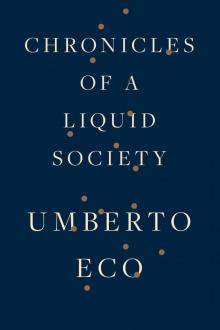 Chronicles of a Liquid Society
Chronicles of a Liquid Society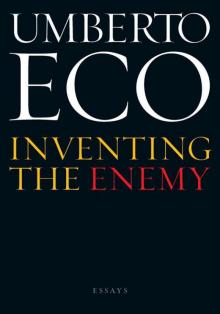 Inventing the Enemy: Essays
Inventing the Enemy: Essays Foucault's Pendulum
Foucault's Pendulum How to Travel With a Salmon & Other Essays
How to Travel With a Salmon & Other Essays Numero zero
Numero zero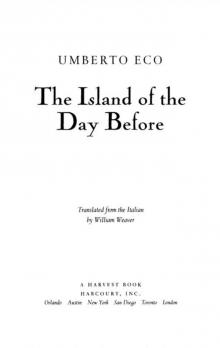 The Island of the Day Before
The Island of the Day Before UMBERTO ECO : THE PRAGUE CEMETERY
UMBERTO ECO : THE PRAGUE CEMETERY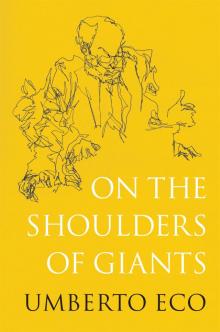 On the Shoulders of Giants
On the Shoulders of Giants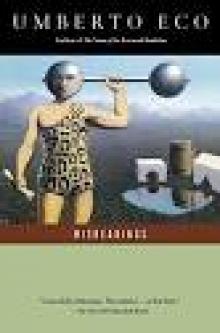 Misreadings
Misreadings Six Walks in the Fictional Woods
Six Walks in the Fictional Woods The Mysterious Flame Of Queen Loana
The Mysterious Flame Of Queen Loana The Prague Cemetery
The Prague Cemetery On Literature
On Literature Lost structure
Lost structure